If your pet’s carrying extra weight, you’re probably wondering how to help them get back in shape. The key is starting slow—think low-impact activities first, then gradually building stamina while keeping an eye on their comfort.
I’ve seen too many pet parents jump straight into intense workouts. That can actually harm an overweight animal, so let’s not go there.
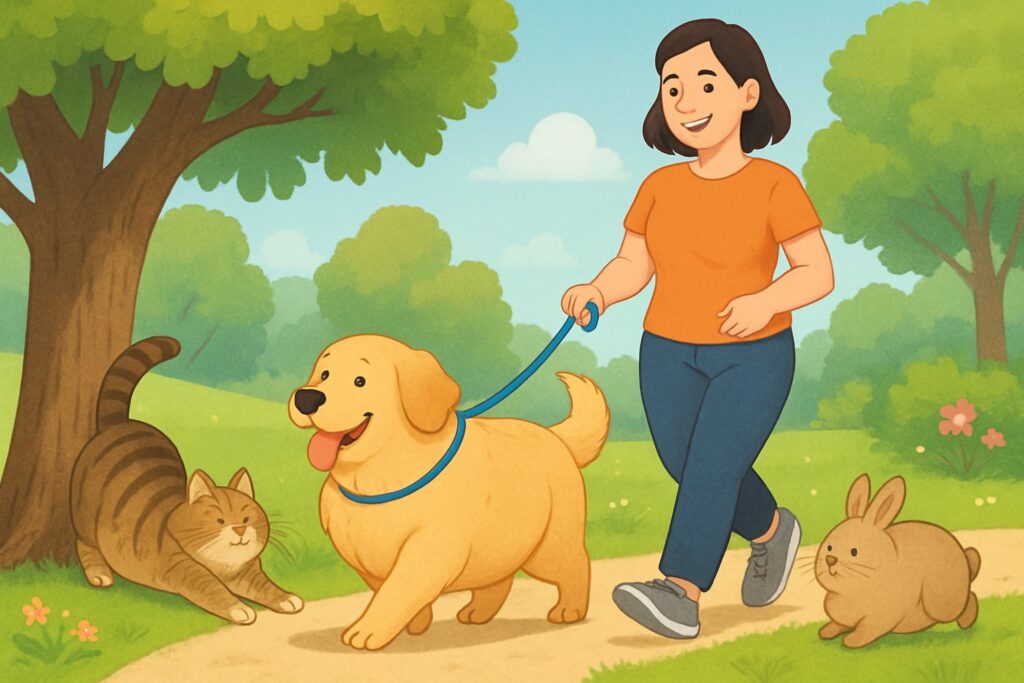
Table of Contents
The truth is, overweight pets often live sedentary lives because their owners don’t realize how much activity they actually need.
But here’s what I find exciting—research shows that people and pets exercising together can be incredibly effective for weight loss in both species.
You’re about to discover the exact exercise strategies that work best for overweight pets. From gentle starter routines to fun activities, you’ll find ways to make workout time something your furry friend might actually look forward to.
I’ll walk you through safe ways to assess your pet’s fitness level. Let me show you how to create a routine that sticks.
Exercise Tips for Overweight Pets – Key Takeaways
- Start with short, gentle activities like slow walks and gradually increase duration as your pet builds stamina
- Always consult your vet before beginning any exercise program to ensure your pet is healthy enough for increased activity
- Combine consistent exercise with proper diet management for the most effective and lasting weight loss results
Why Exercise Matters for Overweight Pets
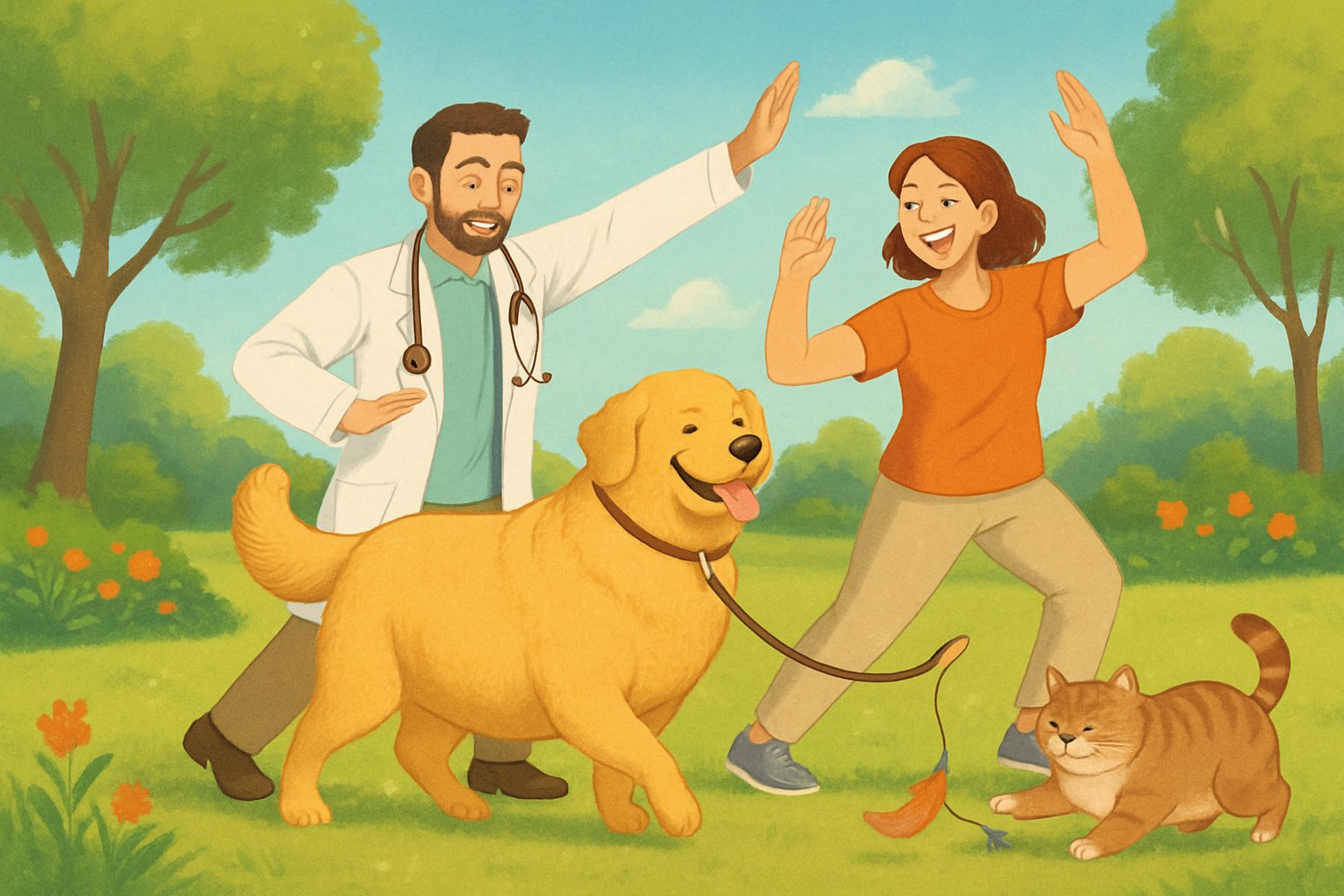
Pet obesity creates serious health problems that affect your furry friend’s quality of life. Regular physical activity helps manage weight and prevents long-term complications that can be costly to treat.
Health Risks of Pet Obesity
Let’s be real—those extra pounds on your pet aren’t just cute chub. They’re setting up your dog or cat for some serious health problems down the road.
Obesity in pets leads to diabetes, joint pain, and heart disease. I’ve watched too many pet parents struggle with these expensive conditions that could have been prevented.
Major health risks include:
- Diabetes – Extra weight makes insulin less effective
- Joint problems – Hips, knees, and spine take a beating
- Heart disease – The heart works overtime pumping blood
- Breathing issues – Fat around the chest makes breathing harder
- Shorter lifespan – Overweight pets live shorter lives
The scary part? Many pet owners don’t realize their furry friend is overweight until these problems start showing up.
Benefits of Regular Activity
Here’s where things get exciting—exercise isn’t just about weight loss. It’s about giving your pet their best life possible.
When I work with pet families, I always emphasize that regular exercise helps maintain lean muscle while burning fat. It’s like hitting two targets with one arrow.
Exercise benefits your pet by:
- Burning calories – Direct fat loss and weight management
- Building muscle – Stronger muscles support joints better
- Improving mood – Happy pets are less anxious and destructive
- Better sleep – Tired pets rest more peacefully
- Stronger heart – Cardio keeps the heart healthy
Think of it this way—would you rather spend money on fun activities with your pet, or expensive vet bills later?
How Extra Weight Impacts Dogs
Ever watched an overweight dog try to climb stairs? It breaks my heart every time.
Extra weight puts tremendous stress on your dog’s joints and organs. The costs of treating obesity-related conditions can drain your wallet fast.
Weight impacts dogs through:
- Joint stress – Every extra pound adds pressure to bones
- Reduced mobility – Simple activities become difficult
- Heat intolerance – Fat insulates, making cooling harder
- Lower energy – Carrying extra weight is exhausting
I always tell pet parents to imagine carrying a heavy backpack all day. That’s what your overweight dog feels like just walking around the house.
The good news? Issues from obesity can be prevented through proper diet and exercise. You have the power to change your pet’s future starting today.
Getting Started Safely: Assessing Your Pet Before Exercise
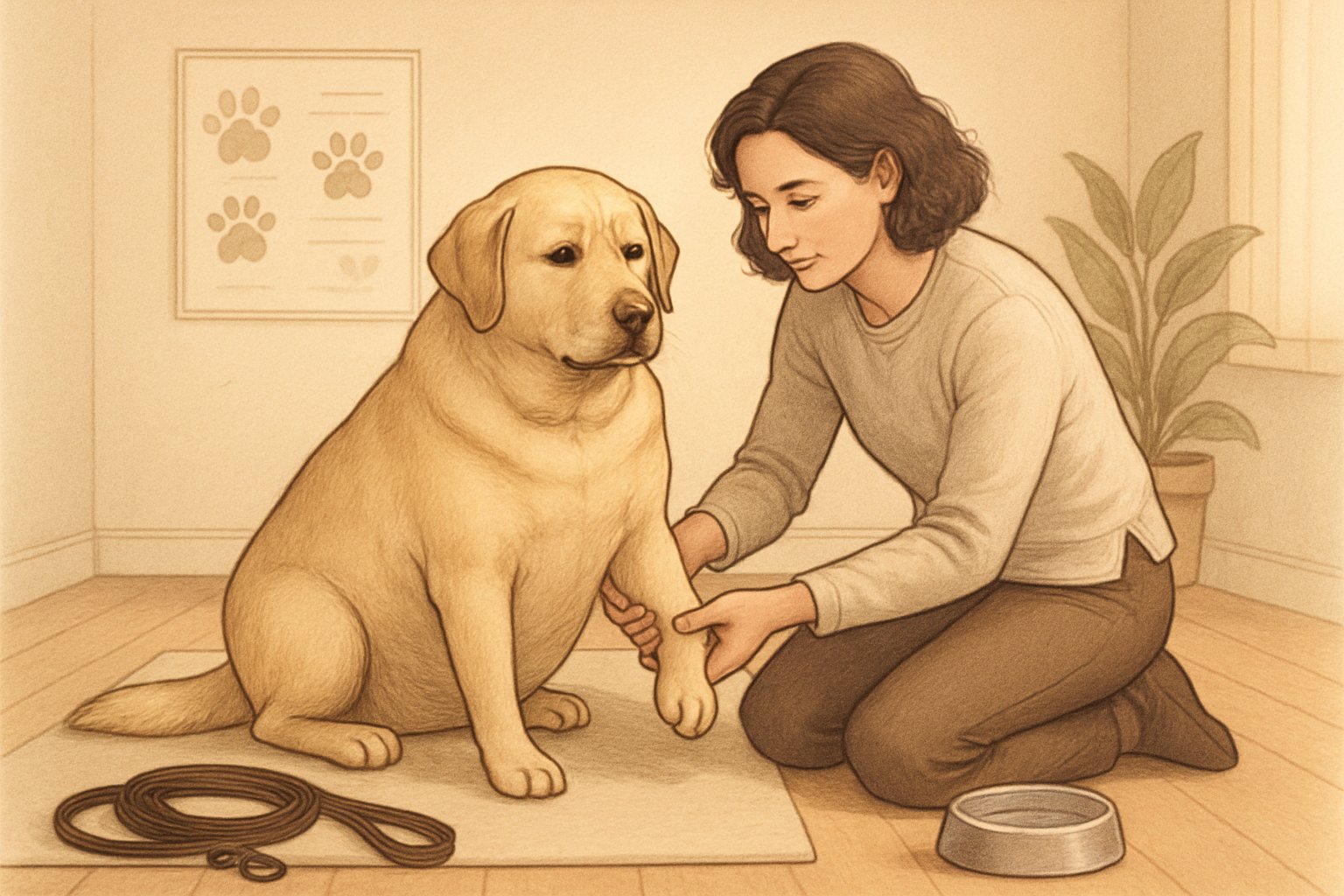
Before diving into any exercise routine with my overweight dog, I need to understand their current health status. Setting realistic expectations protects my pet from injury and sets us both up for success.
Healthy Weight Check and Vet Visits
I can’t stress this enough—your vet visit comes first. Period.
My overweight pets need medical clearance before I start any new exercise routine. Here’s what I ask my vet to check:
- Heart and lung function
- Joint health (especially hips and knees)
- Blood pressure levels
- Diabetes screening
- Thyroid function
I learned this the hard way when my Golden Retriever started limping after our first walk. Turns out, she had early arthritis I didn’t know about.
During the visit, I get my pet’s Body Condition Score (BCS).
Veterinarians use these scores to assess safe weight loss rates and track progress. My vet also helps me calculate target weight ranges.
For example, if my 80-pound Lab should weigh 65 pounds, we plan for gradual 1-2 pound monthly losses.
Red flags that need immediate attention:
- Excessive panting during rest
- Limping or stiffness
- Difficulty breathing
- Lethargy or weakness
Setting Realistic Fitness Goals
I’ve made the mistake of expecting too much too soon. Trust me—slow and steady wins.
Research shows that people and pets exercising together achieve better results, but only when goals stay realistic.
My 4-Week Starter Plan:
- Week 1-2: 5-10 minute gentle walks daily
- Week 3-4: 15-20 minute walks with slight inclines
- Month 2: Add swimming or longer walks
- Month 3+: Include playtime and agility basics
I track these metrics weekly:
- Distance walked without heavy panting
- Recovery time after exercise
- Energy levels throughout the day
- Weight changes (monthly, not daily)
Smart goal example: Instead of “lose 20 pounds,” I aim for “walk 20 minutes without stopping by month two.”
For cats, I start with 2-3 minutes of interactive play twice daily. Indoor cats especially need gradual increases.
Recognizing Physical Limitations
Every overweight pet has unique challenges I have to respect.
Age-related considerations:
- Puppies under 18 months: Joint plates aren’t fully developed
- Senior pets (7+ years): May have hidden arthritis or heart issues
- Middle-aged pets: Often the best candidates for exercise programs
I watch for these warning signs during activity:
Stop immediately if I see:
- Excessive drooling or panting
- Blue or pale gums
- Stumbling or weakness
- Refusal to continue moving
- Vomiting or diarrhea after exercise
Breed-specific limitations matter too. My friend’s Bulldog can’t handle the same routine as my Border Collie.
Flat-faced breeds overheat quickly, while long-backed breeds (like Dachshunds) need low-impact activities.
Environmental factors I consider:
- Hot weather: Exercise only in early morning or evening
- Cold weather: Shorter sessions for thin-coated breeds
- Surface type: Soft grass over concrete when possible
I’ve learned that owners who understand their pet’s physical responses see better long-term results.
The key? I listen to my pet’s body language more than my exercise schedule.
Tailored Exercise Routines for Overweight Dogs
Creating exercise routines for overweight dogs requires a gradual approach that builds endurance without overwhelming your pup.
I’ve found that starting slow with low-impact activities and monitoring your dog’s response helps create sustainable habits that stick.
Low-Impact Workouts: Walking & Swimming
Let’s be real — your overweight dog isn’t ready for a marathon tomorrow. I recommend starting with gentle 10-15 minute walks twice daily.
Watch your dog’s breathing during these walks. If they’re panting hard or falling behind, it’s time for a water break.
Swimming is my go-to for heavy dogs. The water supports their joints and offers solid cardio without pounding on their body.
Many physical training programs integrate water-based exercise because it’s easier on arthritic joints.
Weekly Walking Schedule:
- Week 1-2: 10 minutes, twice daily
- Week 3-4: 15 minutes, twice daily
- Week 5-6: 20 minutes, twice daily
- Week 7+: 25-30 minutes, twice daily
If you have access to a dog-friendly pool or lake, aim for 5-10 minute swimming sessions. The resistance helps burn calories without stressing their bones.
Indoor Play When Outdoor Isn’t an Option
Bad weather shouldn’t derail your dog’s progress. I’ve found indoor activities can be just as effective for weight loss.
Try these energy-burning games:
Stair Climbing: Have your dog walk up and down stairs 3-5 times. Start slow and add more as they get used to it.
Hide and Seek: Hide treats around the house to get your dog moving and thinking.
Tug-of-War: Short 2-3 minute sessions get their heart rate up without overdoing it.
Interactive Toys: Puzzle feeders make your dog work for their food, burning calories while eating.
I love using hallway fetch for small spaces. Roll a ball down the hallway and let your dog chase it. It’s low-impact but keeps them moving.
Monitoring Energy and Progress
Here’s the thing — you need to track what’s actually working. I suggest keeping a simple exercise log with your dog’s energy levels and weight changes.
Weekly Check-ins:
- Weight (same scale, same time)
- Energy level (1-10 scale)
- Exercise tolerance
- Joint stiffness or pain
Your dog should seem more energetic after 2-3 weeks, not more tired. If they’re dragging or showing signs of joint pain, scale back the intensity.
Exercise sessions should be tailored for each dog based on their individual capabilities and health conditions.
Take progress photos monthly. Sometimes the scale doesn’t show changes, but you’ll notice a smaller waistline or better muscle tone in photos.
If your dog seems unusually tired or reluctant to exercise after several weeks, talk to your vet. They might need tweaks to their routine or a health check.
Fun, Playful Ways to Get Your Overweight Pet Moving
Exercise routines don’t have to feel like work for your overweight dog. The best workouts happen when your pet thinks they’re just having fun playing games, hanging out, or chasing after their favorite toys.
Turn Playtime Into Exercise
Let’s be honest — your overweight dog isn’t going to get excited about a boring treadmill session. But throw a tennis ball? Now we’re talking.
I’ve found chase games work incredibly well for overweight dogs. Start with gentle tosses across the living room. Your pup gets their heart pumping without realizing they’re exercising.
Hide and seek is another winner. Hide behind furniture and call your dog’s name. When they find you, celebrate like they just won the lottery.
This gets them moving through the house and builds your bond. Try stair climbing games if you have steps. Toss a favorite toy up a few stairs and let your dog retrieve it.
Start with just 2-3 steps for heavy dogs to avoid joint stress. Tug-of-war engages their whole body. Use a rope toy and let them “win” sometimes. This builds confidence and burns calories through resistance play.
Water games are perfect for joint-friendly exercise. A kiddie pool in the backyard or sprinkler time gets them moving without pounding on their joints.
Interactive Toys and Games
Honestly, the right toys can turn your couch potato pet into an active player without you doing much.
Puzzle feeders make mealtime into exercise time. Instead of gobbling food from a bowl, your dog has to work for every bite. They’ll push, paw, and move around to access their kibble.
Treat-dispensing balls are game-changers for overweight dogs. Fill them with healthy snacks and watch your pup roll, chase, and bat at the ball to get rewards.
It’s like a treasure hunt that burns calories. I love snuffle mats for indoor activity. Scatter treats or kibble in the fabric strips.
Your dog will spend 15-20 minutes sniffing and searching, which counts as mental and light physical exercise. Remote-controlled toys can get lazy pets moving when you can’t.
Drive the toy around corners and under furniture. Your dog’s hunting instincts kick in as they chase and pounce.
Laser pointers work great for cats and some dogs. Just remember to end the game with a physical toy they can actually “catch” to avoid frustration.
Social Motivation: Playdates and Group Walks
You know that look your dog gives you when they see their best friend at the park? That excitement is pure motivation fuel.
Research shows that dogs motivate physical activity better when social elements are involved. Your overweight dog will run around with buddies when they won’t budge alone.
Group walks with other dog owners create accountability for you and excitement for your pet. Find local walking groups or start one in your neighborhood.
Dogs feed off each other’s energy. Dog park visits let your overweight dog set their own pace. They might start slow, but seeing other dogs play often sparks their interest.
Monitor them closely and take breaks as needed. Playdates in fenced yards work perfectly for controlled exercise.
Two dogs will naturally engage in chase games, wrestling, and exploration that burns serious calories. If you have multiple pets, use their relationships to encourage movement.
Cats often become more active when they have dog siblings to play with. Dogs get competitive and want to join in when they see other pets getting attention.
Try scheduling regular meetups with pet parent friends. Your overweight dogs get exercise while you get social time. Everyone wins.
Making Success Stick: Consistency, Diet, and Motivation
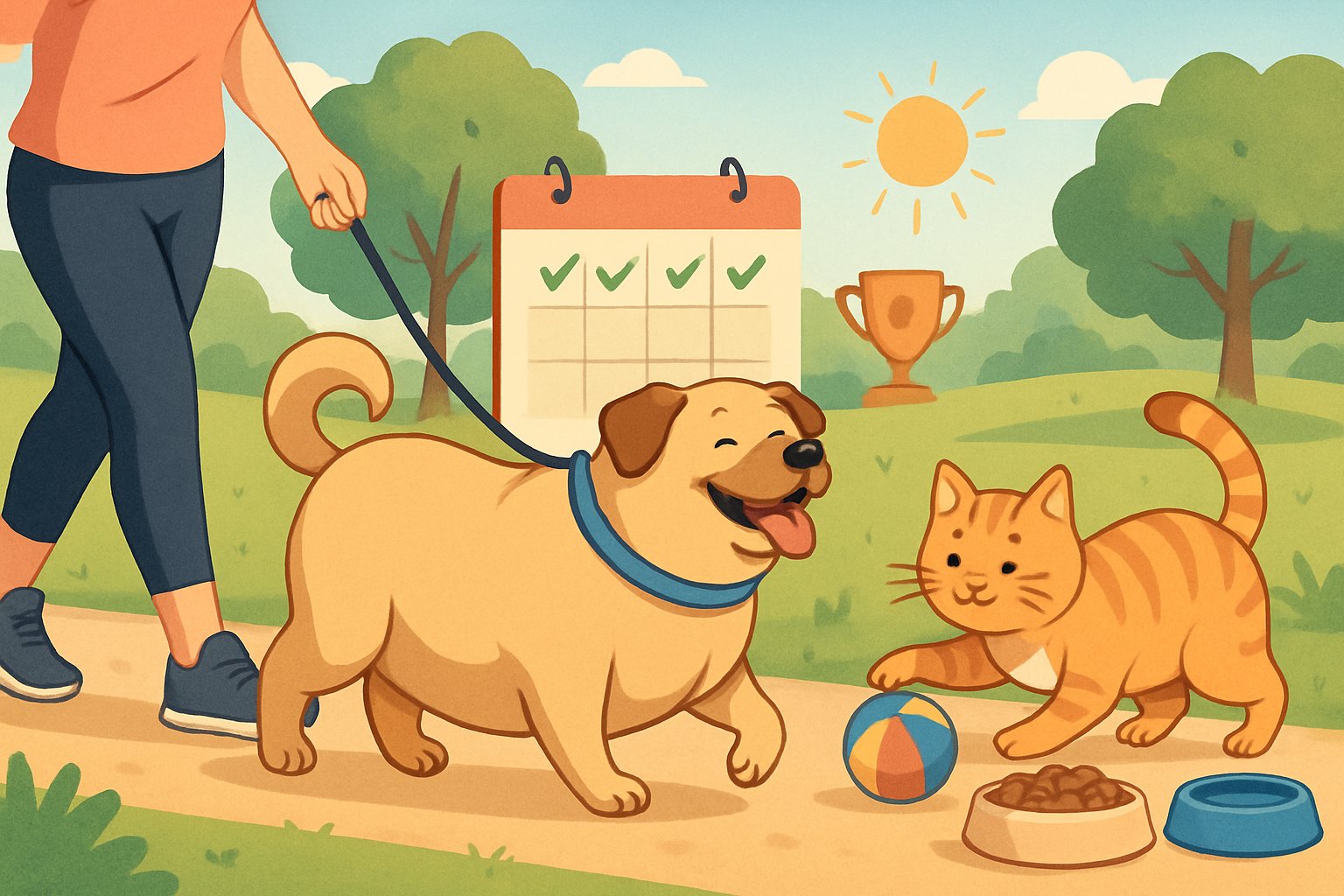
When I work with pet parents dealing with overweight pets, I see the same pattern: early excitement, then frustration when results slow down. The secret isn’t just exercise—it’s building habits that stick and pairing movement with smart nutrition choices.
Sticking to a Routine
I’ve watched so many pet owners start strong with exercise plans, only to quit after two weeks. Your overweight pet needs consistency more than intensity.
Start small and build momentum. I recommend beginning with just 10-minute walks daily, not ambitious hour-long hikes.
Your dog’s joints need time to adapt, and honestly, you need time to form the habit too. Set specific times for exercise. I tell my clients to link walks to existing routines—right after morning coffee or before dinner prep.
This creates what I call “habit stacking.” Track your progress visually. Use a simple calendar and mark off each day you exercise together.
I’ve seen this simple trick work wonders for motivation. The research backs this up: consistent communication from veterinary team members helps pet parents stick to weight management plans seven times better than inconsistent guidance.
Weather will test your commitment. I keep backup indoor activities ready—stair climbing, hallway fetch, or even dancing together in the living room.
Combining Diet Changes with Exercise
Exercise alone won’t solve pet obesity—I learned this the hard way with my first overweight rescue dog. You need both pieces of the puzzle working together.
Timing meals around exercise matters. I feed my pets about an hour after our walks, not before. This prevents stomach upset and helps with digestion.
Low-fat, consistent diets provide better weight loss results when combined with regular activity.
I work with my vet to choose the right food, then stick to exact portions. Measure everything. I use a kitchen scale, not the scoop that came with the food.
Eyeballing portions is where most weight loss plans fail. Consider this approach:
- Morning: Light meal, then walk 30 minutes later
- Afternoon: Exercise session, then water break
- Evening: Main meal after cool-down period
I’ve noticed that commercial diets provide convenience and consistency that helps overweight pets succeed long-term.
Encouraging Progress with Positive Reinforcement
I see too many pet parents focusing on what their overweight pets can’t do. They forget to celebrate small wins, and that mindset kills motivation fast.
Celebrate non-scale victories. When my dog started climbing stairs without panting, that was huge progress—even before the weight dropped.
Look for these moments every day. They’re easy to miss if you’re only watching the scale.
Use praise strategically during exercise. I give an enthusiastic “good job!” every few minutes on walks, not just at the end.
This keeps energy high. It also makes the whole thing more fun for both of us.
Photo progress works better than scales. I take weekly photos from the same angle and distance.
Visual changes often show before the numbers move. Sometimes, that’s all the encouragement you need to keep going.
Create exercise rewards that aren’t food-based. After good workouts, I hand out extra belly rubs, a favorite toy, or we try an exciting new walking route.
Food motivation should be encouraged at appropriate times—like using tiny training treats during exercise to keep engagement up.
Keep a success journal. I jot down one positive thing after each exercise session. Stuff like “Walked further today” or “Seemed more energetic” really builds momentum.
Frequently Asked Questions
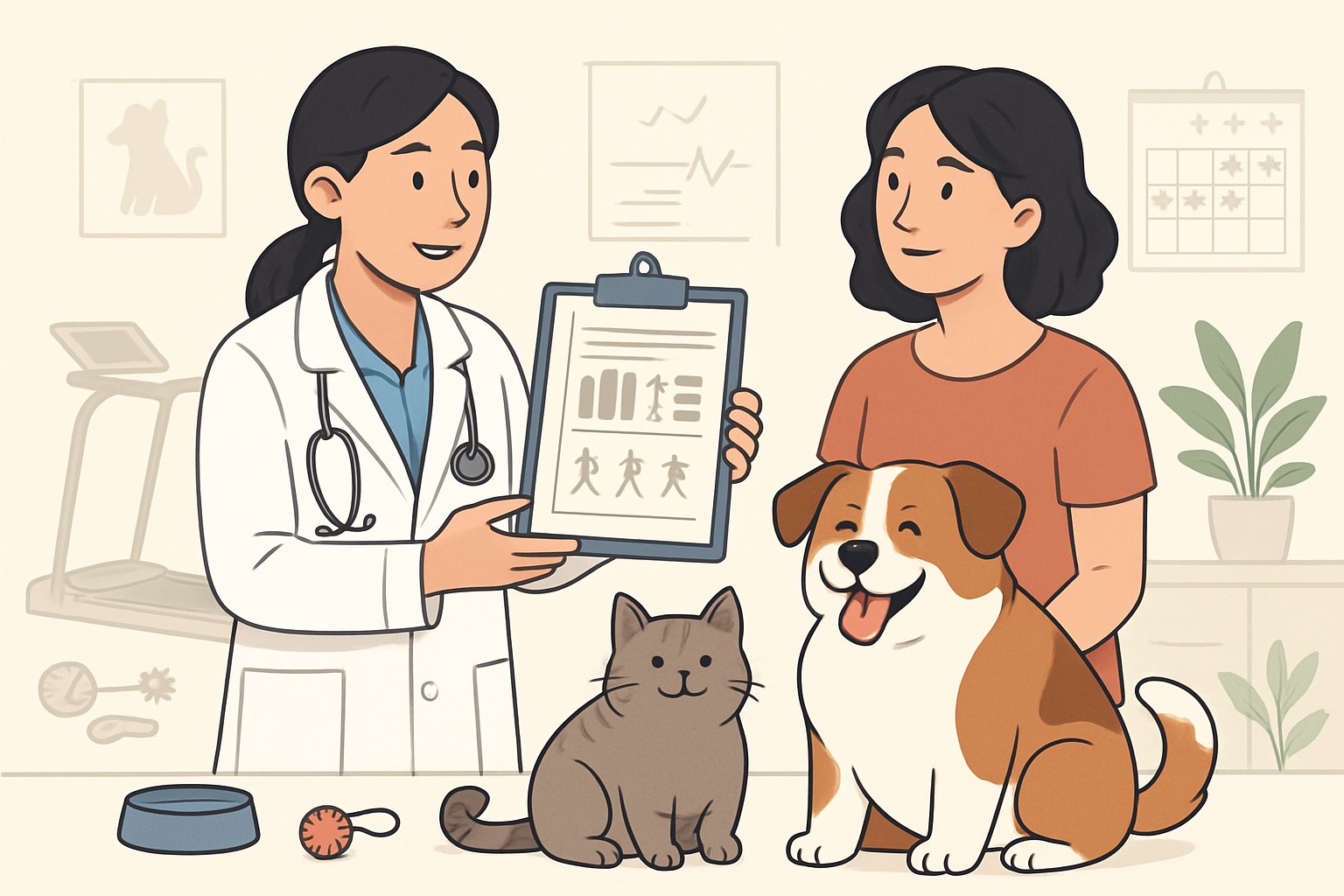
Pet owners have real questions about helping their furry friends lose weight safely. I’ve answered the most common concerns about portion control, timeline expectations, and vet-approved strategies below.
Let’s be real, ever wondered what’s the golden amount of food to help Rover slim down?
I get this question constantly. Here’s the truth: there’s no magic number that works for every dog.
Your vet needs to calculate the exact calories based on your pet’s ideal weight, not their current chunky status. Most overweight pets need about 60-70% of their normal food intake.
Start with measuring cups, not guessing. So many pet parents think they’re feeding “a little bit” when they’re actually doubling portions.
Low-fat foods with added L-carnitine help cats lose fat safely while keeping muscle mass. The same principle applies to dogs.
Switch to a prescription weight management food if your regular kibble isn’t cutting it. These foods pack more nutrition into fewer calories.
If you’ve ever thought, ‘How quickly can my fluffy friend go from chunky to chic?’, here’s what’s up.
I hate to break it to you, but crash diets don’t work for pets any better than they do for us.
Safe weight loss for dogs and cats means losing 1-2% of their body weight per week. That’s about half a pound weekly for a 25-pound dog.
Expect the journey to take 3-6 months minimum. I know it feels slow when you’re watching every treat, but rapid weight loss can damage your pet’s liver and muscles.
Your pet didn’t gain the weight overnight. They won’t lose it overnight either.
Ever faced the dilemma of strict diets or fun playtime for doggy weight loss?
Why choose? I always tell pet parents that exercise and diet work best as a team.
You can’t out-exercise a bad diet, but you definitely can’t diet away a couch potato lifestyle. Increasing physical activity to 20-30 minutes per day makes a real difference.
Start with 5-minute walks if your pet is seriously out of shape. I’ve seen too many owners go from zero to hero and end up with injured, discouraged pets.
Swimming beats jogging for overweight pets with joint issues. The water supports their weight while they burn calories.
You know that look your pooch gives you when it’s dinner time? How to tell it’s on a diet without breaking your heart.
Those puppy dog eyes hit different when you’re cutting portions. I know.
Feed smaller meals more often instead of one sad-looking bowl. Three small meals feel more generous than one tiny dinner.
Use puzzle feeders or snuffle mats to make mealtime last longer. Your pet feels more satisfied when they “work” for their food.
Green beans, carrots, and plain pumpkin make great low-calorie fillers. I mix these into regular food so pets don’t feel cheated.
Replace high-calorie treats with praise, play, or tiny pieces of their regular kibble. Most dogs care more about your attention than the actual food.
Think your pup’s silhouette is fuller than it should be? Where do they stand on a vet’s weight chart?
I use something called a Body Condition Score (BCS) to evaluate pet weight objectively.
Muscle condition scoring helps determine ideal weight for each individual pet. Your vet will check both fat coverage and muscle mass.
You should feel your pet’s ribs easily with light pressure. If you have to press hard or can’t find them at all, we’ve got work to do.
Looking from above, your pet should have a visible waist tuck behind their ribs. From the side, their belly should tuck up toward their back legs.
Most pets score between 1-9 on the BCS scale, with 4-5 being ideal. Anything over 6 means it’s time for a weight management plan.
Ever eavesdropped on the vet’s top secret dog food recommendations for weight loss? Here’s the skinny.
There’s no secret conspiracy. I just want foods that actually work without starving your pet.
Look for the AAFCO statement on the bag that says “complete and balanced.”
Weight loss foods still need to meet all nutritional requirements. That’s non-negotiable.
Prescription diets like Hill’s r/d or Royal Canin Satiety use special fiber that helps pets feel full on fewer calories.
They’re worth the extra cost, honestly. Your dog will notice the difference.
High-protein diets help promote weight loss and reduce muscle loss during dieting.
Aim for foods with protein as the first ingredient. This makes a real difference for your pup’s health.
Skip the grain-free trend for weight loss.
These foods often pack more calories and less fiber than traditional formulas, which just doesn’t help.
Human food should make up less than 10% of your pet’s daily calories.
That includes “healthy” options like sweet potato and chicken breast. Even the good stuff adds up fast.



Leave a Reply